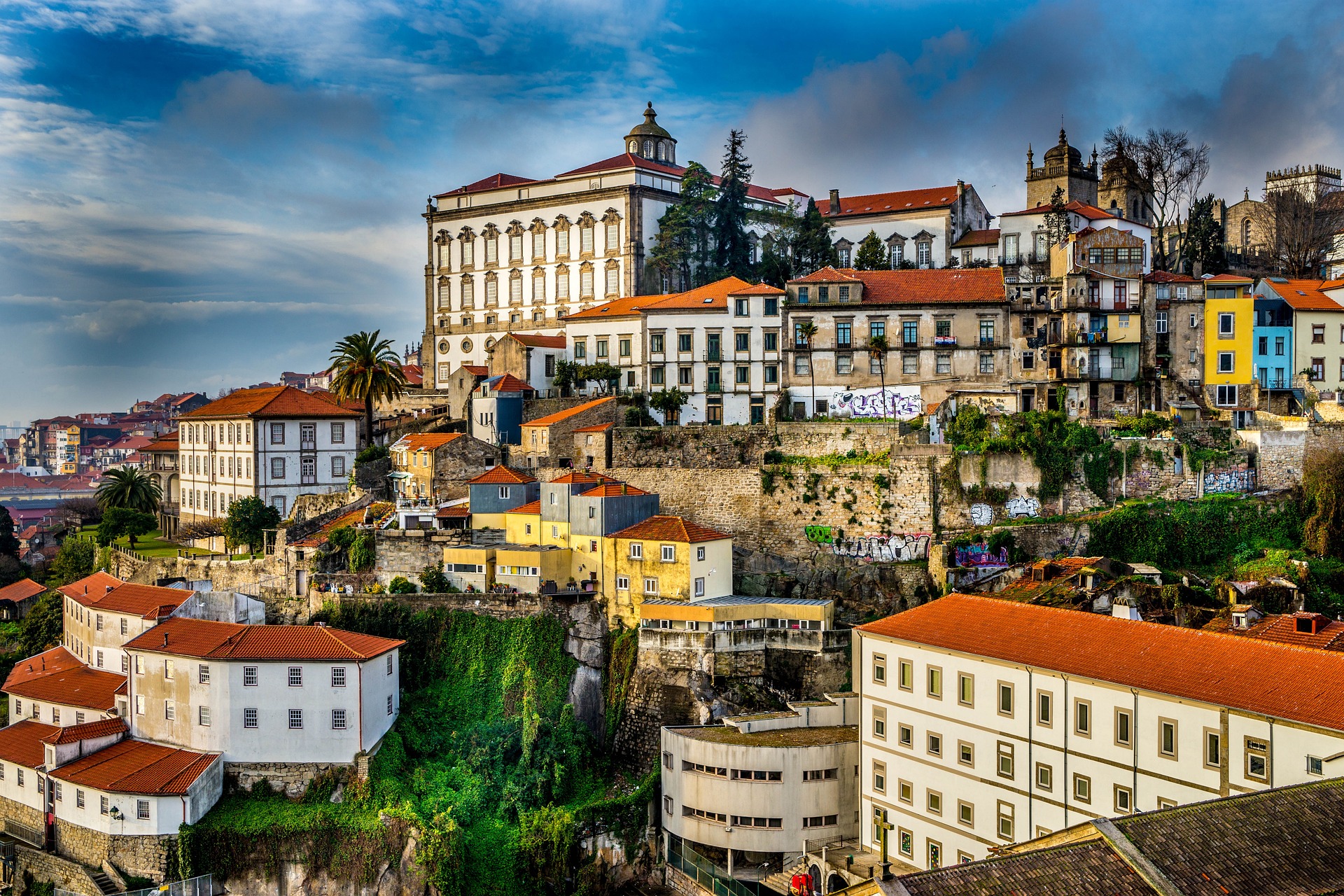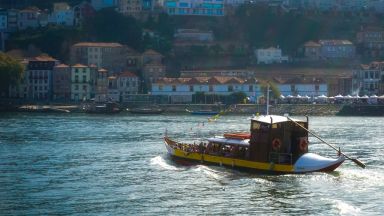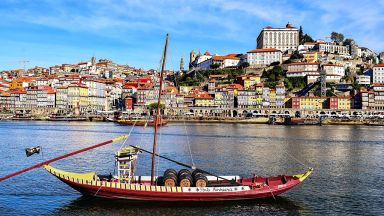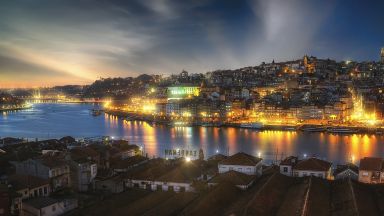Guide to the Areas of Porto
This website uses affiliate links which earn a small commission at no additional cost to you.
Porto sits on the northern banks of the Douro River, with the city extending westwards towards the Atlantic Ocean. To the south of the river is the city of Vila Nova de Gaia, but it is usually considered part of Porto in terms of tourism. If this is your first trip to Porto, the best districts and neighbourhoods to visit are Ribeira, Vitória, Vila Nova de Gaia, Se, Baixa, Bolhão and Ildefonso.
- Ribeira – Best for sightseeing
- Baixa – Best for nightlife!
- Aliados & Bolhão – Best to see Azulejos
- Vila Nova de Gaia – Best for wine lovers
- The Foz district – Best Beach Escape!
- Cedofeita, Santo Ildefonso, Sé, Miragaia, São Nicolau and Vitória – Best for galleries and street art
- Bonfim – Best for affordable accommodation
- Other Districts in Porto
- Bolhão and Ildefonso
- South Massarelos
- Boavista and the Avenida da Boavista
Ribeira – Best for sightseeing
Ribeira is a charming and vibrant neighbourhood located along the riverfront in Porto. Known for its narrow streets lined with colourful buildings, it is a popular spot for visitors to explore. The area is home to a variety of quaint cafes, authentic restaurants, lively bars, and small shops.

Ribeira is a historic district located in the centre of the old town in Porto. It has been a UNESCO World Heritage Site since 1996 and is a popular attraction for visitors from around the world. The history of the area dates back to the 14th century, when trade was offloaded at the Ribeira quayside for distribution throughout the city.
Now, the wide, picturesque promenade along the waterfront has plenty of outdoor seating for visitors to rest and take in the views of the Port houses on the opposite bank. Behind the promenade, you can find cafes, bars, restaurants, and souvenir shops along the waterfront, while tall, colourful houses rise up the hill alongside the narrow, winding streets.
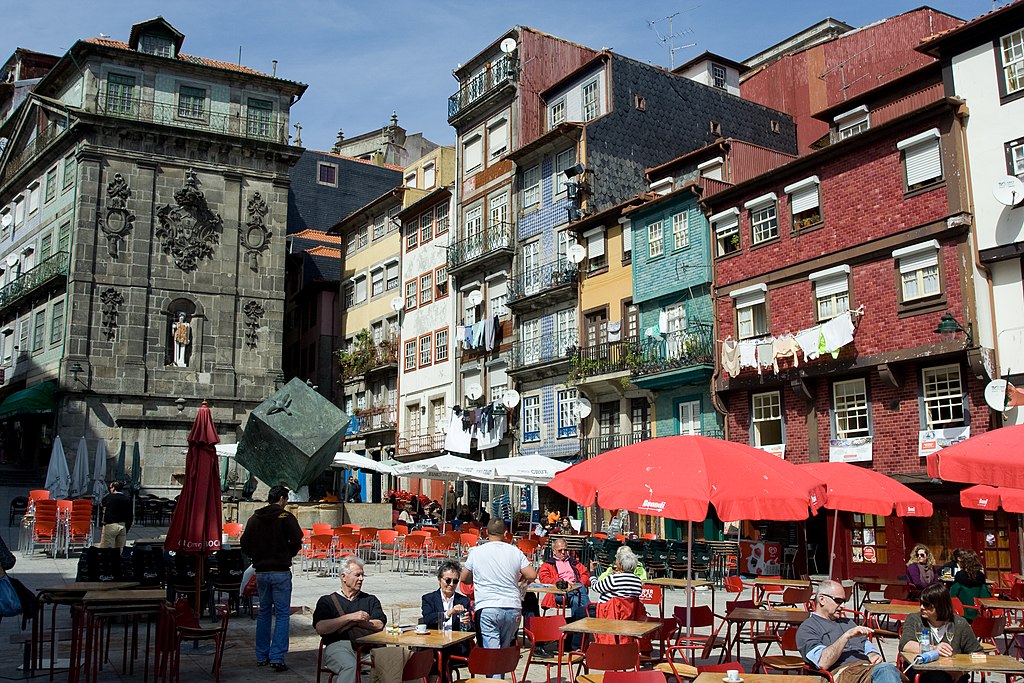
The Praça da Ribeira (Ribeira Square) is the hub of this charming medieval area and the center of night-time activities. The square features a massive granite wall depicting the Portuguese coat of arms, alongside a statue of John the Baptist. Visitors can also dine and wine in the many bars and restaurants around the square.

For those interested in sacral architecture, a climb up the steep, narrow lanes from the square will take you to the hilltop and the fort-like Porto Cathedral. Although originally built in the 12th century, it was rebuilt in the 13th century and modified in the 18th century. Some of the old stonework still survives, along with a 14th century Gothic cloister and rose window inside.
Baixa – Best for nightlife!
The grand centre of Porto, much of which was rebuilt in the early 20th century. Many of Porto’s classic hotels can be found here, and the southern side of the district is a highly recommended area to stay in.
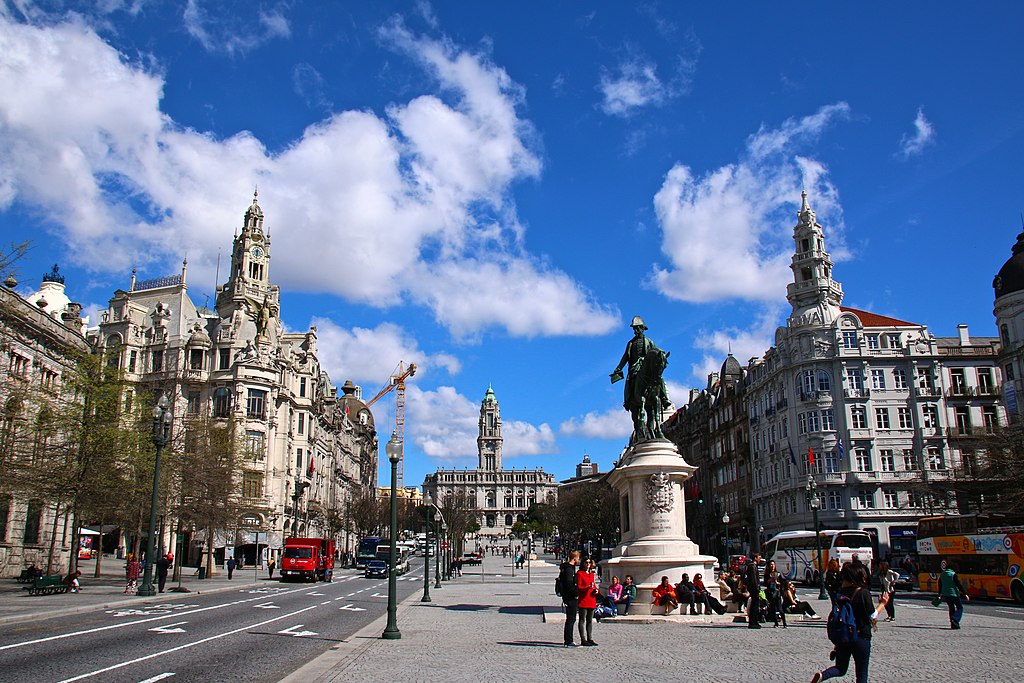
Centro Baixa is a district in Porto that stretches from the Avenida dos Aliados at one end to Praça da Liberdade at the other. It is known for being the centre of Porto’s local administration, with the Municipal Council Building located at the top of the avenue.
The streets west of Aliados, particularly Rua Galeria de Paris, are known for their bustling nightlife. On weekends, the streets and surrounding plazas come alive with activity. Visitors can also find a variety of cafes, bookstores (including one with a Harry Potter theme), and diverse restaurants that cater to different budgets. The lodging options in the area are diverse as well, with five-star hotels, budget-friendly guesthouses and trendy hostels like the Passenger to choose from.
Before 2004, the area was in decline with businesses closing, buildings deteriorating, and residents moving to other areas. However, in 2004, things began to change as the area was classified as a World Heritage Site. Buildings were renovated, smaller properties were refurbished, and new businesses, particularly in the hospitality sector, opened up. As a result, it has become a popular place to stay in Porto.
Some of the notable buildings in the area include the São Bento Railway Station with its tiled entrance hall, the Church of Misericordia with its impressive baroque façade, and the Clérigos Church with its magnificent tower, which provides stunning views of the city from 75 meters up. Visitors who have a love of gold can take a stroll down Rua das Flores, where they can find local goldsmiths’ stores and workshops.
Other attractions in the area include the reintroduced tram network, the Dom Luís I Bridge, and guided tours to various Port houses and storage facilities. River cruises are also available.
Aliados & Bolhão – Best to see Azulejos

Another lively and densely packed neighbourhood worth visiting is Bolhão. This neighbourhood boasts a number of sights to explore, but two of the most noteworthy are the Rua de Santa Catarina and the Chapel Almas de Santa Catarina. The Rua de Santa Catarina is a busy boulevard filled with stores, restaurants, and cafes, while the Chapel Almas de Santa Catarina, also known as the Chapel of Souls or St. Catherine Chapel, is an 18th-century church famous for its 15,000+ Azulejos (hand-painted tiles) that adorn its exterior.
Vila Nova de Gaia – Best for wine lovers
Vila Nova de Gaia is a district located on the south bank of the Douro River, known for its stunning views of Porto across the water. It is also a popular destination for wine enthusiasts, as it is home to historic port wine lodges and the World of Wine, where visitors can taste high-quality vintages and learn about vineyard history. The district has charming cobblestone streets with picturesque buildings and a variety of restaurants, but limited nightlife options.
During the day, Vila Nova de Gaia is bustling with tourists, but at night, it becomes more tranquil as most visitors return to Porto. The district offers a small but diverse selection of hotels, hostels, and guesthouses, with some offering breath-taking views of the river and Porto.
The Foz district – Best Beach Escape!
If you’re looking for a break from the crowded streets of the city centre, Foz do Douro is a great option. This peaceful district is situated a little further from the historic centre, at the the westernmost part of Porto by the mouth of the Douro River. It is known for its rugged beaches, promenades, and oceanfront restaurants with views of the waves.

Foz does not have many must-see attractions, but it’s a great spot for a relaxing day at the beach. The vintage No.1 tram is a fun way to get there. It’s also one of the best neighbourhoods for families in Porto. You can spend some free time on the sand or visit nearby kid-friendly spots like the Sealife Porto Aquarium or the Cheese Castle (São Francisco Xavier Fortress).
Cedofeita, Santo Ildefonso, Sé, Miragaia, São Nicolau and Vitória – Best for galleries and street art
Before 2013, the parishes of Cedofeita, Santo Ildefonso, Sé, Miragaia, São Nicolau and Vitória, were individual areas within Porto, some of them with a land area of less than .5 km². Strangely, having merged the communities in 2013, instead of renaming the new parish, the council chose to maintain each individual community name in the title.
Se is the oldest neighbourhood of Porto, which was historically encircled by the city walls. It is named after the Gothic Se Cathedral, and its central location makes it convenient for sightseeing.
Vitória is the former commercial heart of Porto, this district is centered around the university. It offers bustling shopping streets and a lively atmosphere by day, and transforms into the city’s nightlife center at night. The Galerias de Paris and Rua do Almada are the main streets for bars and nightlife in Porto.
Cedofeita is cantered around Rua de Cedofeita, this district offers a more authentic Portuguese experience. However, it can feel a bit distant from many of the main tourist attractions.
Miragaia is a medieval maze of a neighbourhood that is charming, authentic and offers many rental rooms. It is an ideal location if you prefer to be away from the tourist crowds, but be warned, there are many steep hills in this neighbourhood!
Major attractions in Miragaia include the Church of São Pedro, The English Club, the Alfândega Nova (Customs House, and Transport and Communications Museum), the Palácio das Sereias (Staircase and the Sirens’, Palace), and the Soares dos Reis National Museum, where Porto’s finest artwork is housed in the Carrancas Palace.
Bonfim – Best for affordable accommodation
An up-and-coming area of Porto, yet to be ruined by tourism that offers cheaper accommodation and is popular with students. The district has a non-touristy atmosphere and an emerging artisan scene. Bonfim may be a bit too far out for most tourists, but it’s a great option if you want to go beyond the conventional tourist locations. Places to visit in Bonfim include the Igreja de Nosso Senhor do Bonfim (Our Lord of Bonfim Church) and Cemitério Prado do Repouso.
Other Districts in Porto
Bolhão and Ildefonso
This is the shopping neighbourhood of Porto, with a mix of traditional shops, designer stores and numerous restaurants.
South Massarelos
An interesting and alternative area cantered around Jardins do Palácio de Cristal. This is a good location to consider if the more popular accommodation options are running low. However, it is best to avoid the area west of the Arrábida Bridge, as it moves into Bairro Aleixo, one of the most deprived areas of the city.
Boavista and the Avenida da Boavista
The Avenida da Boavista is a grand boulevard, known for its upmarket hotels. This area is ideal for a business trip but is a little out of the way for sightseeing. Hotels in the Boavista neighbourhood often have car parking, making it a good choice if you plan to have a car.
